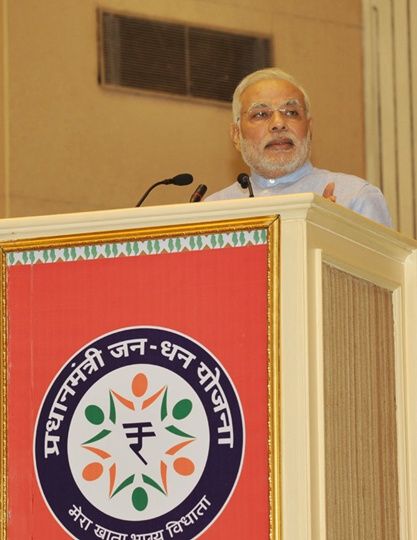
According to data, the rural credit-deposit ratio dropped from 92 per cent in 2010 to 72 per cent in 2014.
When Prime Minister Narendra Modi proclaimed the launch of Jan Dhan Yojna, a financial inclusion scheme, on August 15, 2014, another similar initiative called Swabhimaan, started by the government in 2011, was dying a silent death.
For close to five years, financial inclusion has been on the top of the agenda of the central government.
Yet, the results are just the opposite.
According to data, the rural credit-deposit ratio dropped from 92 per cent in 2010 to 72 per cent in 2014.
The credit-deposit ratio is a key measure to determine the sustainability of banking services.
A low or falling ratio indicates the unviability of rural banking.
In particular, the north-eastern and eastern parts are worst off when it comes to financial inclusion than the rest of the country.
While Bandhan, a privately-run bank, has had some success in the area, others are floundering.
In three months, Bandhan has mobilised more than Rs 2,500 crore (Rs 25 billion) in deposits from rural areas. Government-run United Bank of India, on the other hand, has grown its deposits to only Rs 350 crore (Rs 3.5 billion) in five years since the launch of Swabhimaan.
The government’s financial inclusion plans have gone through several changes over the last five years, but a model that truly works is still to be found.
In 2011, the government launched Swabhimaan, mandating banks to open an outlet in every village with a population of over 2,000 by March 2012.
The plan led to banks opening outlets in nearly 99.7 per cent of the target villages.
In the second phase, the scheme was extended to cover villages with population of at least 1,600 and a common banking correspondent was to be appointed for all public sector banks for up to 20 clusters.
What followed as a result was unbridled competition among agents to work as business correspondents, with service providers willing to dole out as much as 30-40 paise per transaction as commission to banks.
“This was an unscientific approach to financial inclusion.
The frequent changes in banking correspondents sent out a negative message in rural areas. As a result, for about one year from 2012, the work towards financial inclusion went haywire,” says an official of a public sector bank who does not want to be named.
In 2013, the cluster approach to appointing banking correspondents was abandoned.
Several models were tried in between and then in 2014 came along the Jan Dhan Yojna.
Jan Dhan Yojna is an improvisation over all other previous financial inclusion schemes.
The beneficiaries get RuPay debit cards which come with an accident insurance cover of Rs 100,000.
Till November 11, Rs 26,819 crore (Rs 268.19 billion) had been mobilised in deposits under the scheme.
However, much like the previous effort, the scheme does not have any special provision for credit disbursement.
According to banks, rural connectivity has turned out to be the single biggest challenge in implementing the plan.
“As a bank with a mandate of financial inclusion, the biggest challenge we are facing is on the connectivity front,” says C S Ghosh, chief executive officer and managing director, Bandhan Bank.
The government’s emphasis on using RuPay cards for Jan Dhan Yojna is not helping the plan either.
Many say people in the villages find the idea of using a card that comes with an identification pin too cumbersome.
There are other challenges too.
At any time, a banking correspondent carries only Rs 25,000 with him as carrying larger amounts is fraught with risk of theft and robbery.
This means for government plans, like the rural housing scheme or the employment guarantee scheme which require bigger disbursals, villagers often have to walk long distances to banks to withdraw or deposit money.
In addition, the account features of Jan Dhan Yojna are highly restrictive.
The withdrawal limit is Rs 10,000 per month and one can have a maximum deposit of only Rs 100,000.
Image: Prime Minister Narendra Modi at the launch of the PMDJY. Photograph: Kind courtesy, PIB











